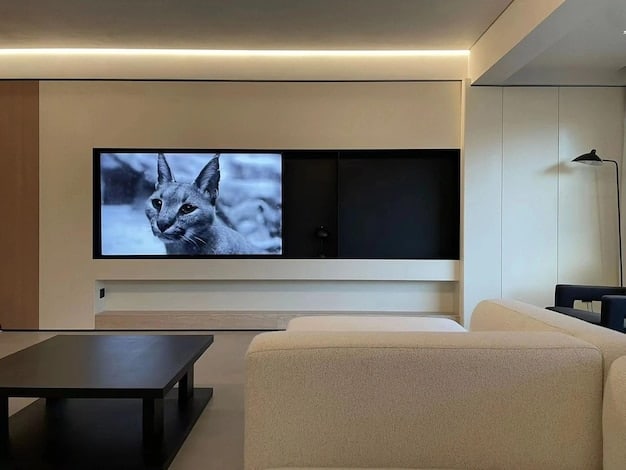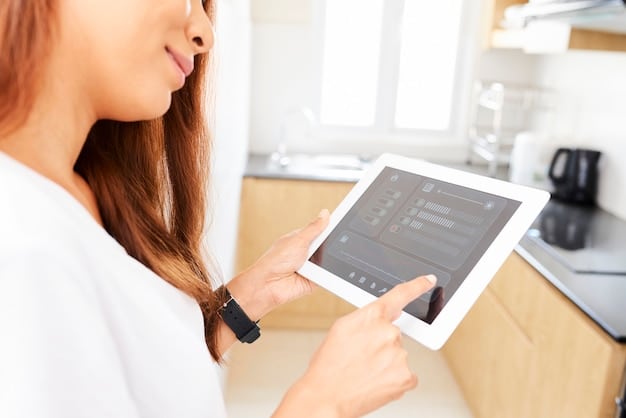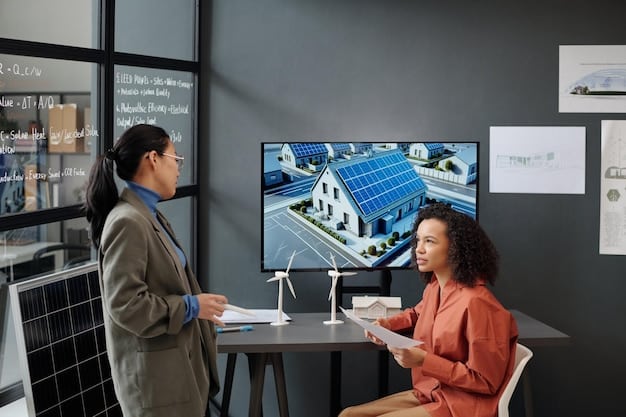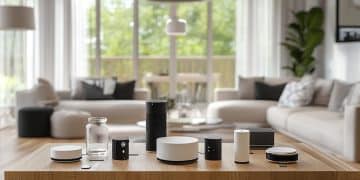Smart Home Trends: Innovations Shaping US Living Spaces in 2025

Smart home trends in 2025 are poised to revolutionize US living spaces with advancements in AI, sustainability, and personalized automation, creating more efficient, secure, and comfortable homes tailored to individual preferences and lifestyles.
The landscape of home living is undergoing a dramatic transformation, with technology at the forefront. As we approach 2025, understanding the **smart home trends** that are set to redefine our living spaces in the US becomes crucial.
The Rise of Personalized Smart Homes
The concept of a smart home is no longer a futuristic fantasy; it’s rapidly becoming a reality. By 2025, the focus will shift from simply automating tasks to creating personalized living experiences that cater to individual needs and preferences.
AI-Driven Customization
Artificial intelligence (AI) is set to play a pivotal role in this personalization. AI algorithms will analyze user behavior, learn routines, and anticipate needs to automatically adjust settings such as lighting, temperature, and entertainment.
Voice Control Evolution
Voice control systems will become even more sophisticated, understanding natural language nuances and responding to complex commands. This will enable seamless interaction with all connected devices, making home management effortless.
- AI learns user habits for automated adjustments.
- Voice control understands nuanced language commands.
- Homes adapt to individual preferences in real-time.
- Personalized smart home experiences boost convenience.
Personalization is the key to unlocking the full potential of smart home technology. As AI and voice control evolve, homes will become more intuitive, responsive, and tailored to the unique lifestyles of their occupants.

Enhanced Home Security Systems
Security is a paramount concern for homeowners, and smart home technology is addressing this need with advanced and integrated security systems. In 2025, expect to see even more sophisticated security solutions encompassing both physical and digital protection.
Biometric Authentication
Biometric authentication methods, such as facial recognition and fingerprint scanning, will become increasingly common for secure home access. These technologies offer a higher level of security compared to traditional locks and keys.
Integrated Surveillance
Smart surveillance systems will feature AI-powered analytics, allowing them to detect suspicious activity, distinguish between family members and strangers, and send real-time alerts to homeowners or security professionals.
- Biometric access control enhances home security.
- AI-powered surveillance detects suspicious activity.
- Smart locks offer remote access and monitoring.
- Integrated systems provide comprehensive protection.
By integrating biometric authentication, AI-powered surveillance, and smart locks, homeowners can create a robust and responsive security system that provides peace of mind and protects their loved ones and valuables.
Sustainability and Energy Efficiency
With growing environmental concerns, sustainability and energy efficiency are becoming central themes in smart home design. The homes of 2025 will be equipped with technologies that minimize energy consumption, reduce waste, and promote a more sustainable lifestyle.
Smart Energy Management
Smart thermostats, lighting systems, and appliance controls will work in tandem to optimize energy usage. These systems will learn energy consumption patterns, adjust settings automatically, and provide insights for further reduction.
Renewable Energy Integration
Homeowners will increasingly integrate renewable energy sources, such as solar panels and wind turbines, with smart home systems. This integration will allow them to monitor energy production, store excess power, and reduce reliance on traditional energy grids.

Sustainability is no longer a niche concept; it’s a core value driving smart home innovation. By embracing smart energy management, renewable energy integration, and water conservation technologies, homeowners can create more sustainable and environmentally friendly living spaces.
The Expansion of Health and Wellness Features
Smart homes are increasingly incorporating features that promote health and wellness, catering to the growing demand for personalized healthcare and well-being. In 2025, expect to see a proliferation of devices and systems designed to monitor and improve physical and mental health.
Smart Health Monitoring
Wearable devices, smart scales, and other health sensors will continuously monitor vital signs, sleep patterns, and activity levels. This data will be analyzed to provide personalized health recommendations and alerts.
Air and Water Quality Control
Smart air purifiers and water filtration systems will automatically monitor and adjust air and water quality levels, ensuring a healthy indoor environment. These systems will remove pollutants, allergens, and other contaminants, promoting respiratory health and overall well-being.
- Smart health monitoring provides personalized insights.
- Air and water quality control promotes a healthy environment.
- Mental wellness features reduce stress and anxiety.
- Integrated systems support holistic health and well-being.
Health and wellness are becoming integral aspects of the smart home experience. By integrating health monitoring, environmental controls, and mental wellness features, homes can become proactive partners in promoting the physical and mental health of their occupants.
Seamless Integration and Interoperability
One of the key challenges in the smart home industry is ensuring seamless integration and interoperability between different devices and platforms. In 2025, standardization and open protocols will become more prevalent, leading to a more cohesive and user-friendly smart home experience.
Unified Control Platforms
Smart home hubs and control platforms will support a wider range of devices and protocols, allowing homeowners to manage all their connected devices from a single interface. This will eliminate the need for multiple apps and simplify home automation.
Cross-Platform Compatibility
Manufacturers will increasingly adopt open standards and APIs, enabling their devices to communicate and interact seamlessly with other smart home systems. This cross-platform compatibility will give consumers greater flexibility and choice.
Seamless integration and interoperability are essential for creating a truly smart and connected home. As unified control platforms and cross-platform compatibility become more widespread, homeowners can enjoy a more cohesive, user-friendly, and customizable smart home experience.
The Influence of 5G and Enhanced Connectivity
The rollout of 5G networks and advancements in wireless connectivity will have a profound impact on the smart home landscape. Faster speeds, lower latency, and greater bandwidth will enable new applications and improve the performance of existing smart home devices.
Enhanced Streaming and Entertainment
5G will enable seamless streaming of high-resolution video and audio content, enhancing the entertainment experience in smart homes. Homeowners can enjoy immersive gaming, virtual reality, and augmented reality experiences without lag or buffering.
Improved IoT Performance
5G will support a greater number of connected devices, allowing for more complex and responsive smart home automation. This will improve the performance of IoT devices such as sensors, cameras, and appliances.
- 5G enhances streaming and entertainment experiences.
- Improved IoT performance enables complex automation.
- Remote monitoring and control become more reliable.
- Faster connectivity supports new smart home applications.
5G and enhanced connectivity are poised to unleash the full potential of smart home technology. With faster speeds, lower latency, and greater bandwidth, homeowners can enjoy seamless streaming, improved IoT performance, and new applications that transform the way they live.
| Key Feature | Brief Description |
|---|---|
| 💡 AI Personalization | Homes adapt to user habits for automated adjustments. |
| 🛡️ Enhanced Security | Biometric access and AI surveillance increase safety. |
| 🌱 Sustainability | Smart energy management and renewable integration reduce waste. |
| 💪 Health & Wellness | Smart monitoring and environmental controls enhance well-being. |
FAQ
▼
Key trends include personalization through AI, enhanced security systems, sustainability and energy efficiency, the expansion of health and wellness features, seamless integration of devices, and the influence of 5G for improved connectivity.
▼
AI algorithms will analyze user behavior and preferences to automatically adjust settings such as lighting, temperature, and entertainment, creating a personalized living experience tailored to individual needs.
▼
Expect advancements such as biometric authentication, AI-powered surveillance systems that can distinguish between family members and strangers, and integrated smart locks with remote access and real-time alerts.
▼
Smart homes use smart thermostats, lighting systems, and appliance controls to optimize energy usage, and integrate renewable energy sources like solar panels, reducing waste and promoting a more sustainable lifestyle.
▼
5G enhances streaming and entertainment with seamless high-resolution content, improves the performance of IoT devices, and enables more complex and responsive smart home automation through faster speeds and lower latency.
Conclusion
As we look towards 2025, the future of US living spaces is undeniably intertwined with the advancements in smart home technology. From personalized AI experiences to enhanced security, sustainable solutions, and improved health features, the smart home trends are set to redefine the way we live, making our homes more efficient, comfortable, and tailored to our individual needs.





